There is an ongoing debate between members of the diving community over the volume of diving masks. Freedivers have always favored a low-volume mask. While snorkelers and scuba divers often do not. What is the big difference, and how to choose the best mask for yourself? Keep reading for an in-depth discussion of low-volume masks and a few reviews too.
| Low Volume Masks | BRAND | EXPERT RATING | PRICE |
|---|---|---|---|
 | Cressi Store |  | |
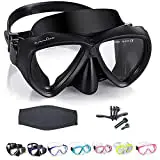 | OMGear Store |  | |
 | ZIONOR Store |  | |
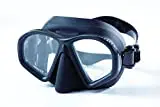 | SHERWOOD SCUBA Store |  | |
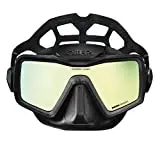 | Omer |  |
What Is A Low Volume Diving Mask?
At first, let us clear things up by defining what exactly is a low-volume diving mask. The volume of a mask refers to the capacity of air it can hold. Obviously, low-volume masks are smaller and more fitted than their high-volume counterparts.
Traditionally, any mask that has a capacity of less than 100ml was considered a low-volume mask. However, all diving mask designs these days are trending towards more fitted contours and a lower volume. Thus, the definition of a low-volume mask is not as clear as it used to be in the past, and many divers aren’t able to differentiate between high and low volume masks.
The difference is usually obvious as you dive deeper into the ocean, especially when trying to equalize pressure. A higher volume mask requires a larger exhale to equalize it with the surrounding water pressure instead of a low-volume mask that requires less air volume.
Who Uses Low Volume Diving Masks?
They are traditionally used in freediving (and spearfishing, which is another form of freediving), and nowadays, they are usually marked as such. They may even be labeled as micro-masks or other ways to signify that they have a lower volume than others.
Generally speaking, divers who prefer to use low-volume masks do not have the luxury of wasting their breath underwater. Using this type of mask can help conserve a diver’s breath, which is its most important feature.
Pros Of Using Volume Diving Masks For Freediving
There are many advantages to using a low-volume mask beyond breath conservation. The trend of decreasing mask capacity is probably due to the same reasons.
Breath Conservation
Because freediving depends on a single breath of air, every ml counts. Wasting your limited amount of air on equalizing or on clearing your mask significantly reduces the time of your freedive. Freedivers use several techniques to stretch out their breath, and using a low-volume mask is one of them.
Equalizing
It is one of the standard techniques that all divers use to avoid barotrauma. Equalizing the pressure in the mask with the water pressure surrounding you will be much easier if it has a lower capacity. You will need to exhale a significantly smaller amount of air to equalize a low-volume mask, which makes it easier to use.
This can also be important for diving to greater depths, as equalizing a mask becomes more difficult due to increased water pressure.
Clearing A Flooded Mask
No matter what kind of mask you use, they will all inevitably flood a little. Whether you use a purge valve or other methods to clear out your flooded mask, it will be much easier if you have a lower volume to deal with.
Vision
Many people find that the design of a low-volume mask gives them a wider (better) field of vision. This is because the lens is close to your eyes, giving an unobstructed view, much like the view from prescription glasses. Your field of view can substantially change your diving experience and make you feel more comfortable in the water.
Additionally, if you need to wear prescription glasses, a low-volume mask is the only way to go, with many masks giving divers the option to fit in prescription lenses directly. Otherwise, using contact lenses is the only other option, which many divers do not favor (in fear of losing their lenses in the water during a dive).
Hydrodynamics
Anyone who swims regularly already knows the importance of hydrodynamic drag. Because low-volume masks are so small and form-fitting, they have reduced drag (slightly), increasing your time underwater efficiency.
Comfort
The design used for these masks is much more comfortable and lightweight. They are also easier to carry for travel and have a better fit for smaller faces.
Disadvantages Of Using A Low Volume Mask
Of course, nothing in this world is perfect – there are a few disadvantages to using a low volume mask, but they are mostly based on opinions and personal choices. For example, people with larger bone structures may find it difficult to fit in these masks. Others may feel claustrophobic or discomfort due to a variety of reasons.
Also, some poorly designed models may have limited vision when compared to high volume masks. Despite the aforementioned drawbacks, the benefits outweigh them, and so low-volume masks are increasingly gaining in popularity.
Product Review
We’ve taken the liberty of scouring the internet for the best low-volume masks for freedivers. These are reviews for the most popular five:
1. Cressi Metis
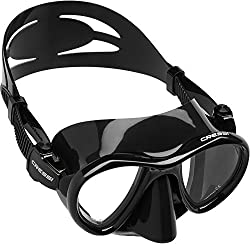
Photo Credit: Amazon
The Italian manufacturer is considered one of the largest in the water sports gear industry, and they have a wide range of products suitable for every diver’s needs. Their Metis freediving mask is a low-volume mask loaded with features and designed specifically for freediving. The internal volume is kept at a minimum, and its compact design helps reduce hydrodynamic drag. We tried this model for an hour-long dive and really enjoyed the experience.
The lenses are made of tempered glass and are perfectly placed to give a clear view. Their teardrop shape gives more field of view (downward). We found minimal leaking from the silicon skirt, which was very comfortable and perfectly sealed. We tried the nose pocket and found it was spacious enough to use for equalization, even with thick neoprene gloves. The mask was also very lightweight and comfortable. They are available in a few colors, including mirror lenses. The only demerit we need to be honest about was that there was no anti-fog coating. A quick application of toothpaste took care of that, but we would have liked to see more from Cressi.
2. OMGear Diving Mask

Photo Credit: Amazon
For such a low price, this diving mask performs exceptionally well. Our diving test with these pair of goggles showed how clear the tempered glass was, with great anti-fog coating (we didn’t use toothpaste this time). The lenses sit close to your eyes, giving a wider visual field. This pair of goggles was not easily flooded, even at great depths – proof that the food-grade silicone skirt works well. The materials used are of high quality, resistant to scratches and shattering. It fits well, with very low volume. Adjusting the mask using the buckle and strap is relatively simple. However, the mask is very hard and maybe uncomfortable to wear for long periods.
A distinguishing feature of this freediving mask is the camera mount, which was very easy to use. With the help of dedicated screws, you can mount a camera securely and take photos or videos underwater easily. Overall, this mask is a great option for freedivers. The quality and design are great for the price point. We also liked the wide range of colors available.
3. ZIONOR M2 Diving Mask
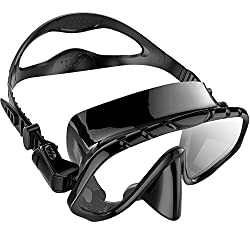
Photo Credit: Amazon
These are another affordable option, with a wider lens made of tempered, scratch-resistant glass. It offers slots for prescription lenses which is a convenient feature to use if you need it. The field of view is quite wide, which is good. However, the added lens width makes this mask slightly higher volume than we’d like. We found it is only suitable for beginner freediving, up to 20 meters. Anything deeper was uncomfortable with the added internal volume of the mask. Equalizing this mask at higher water pressure was very difficult, which may be a bigger problem for divers with less experience.
In any case, the silicon skirt worked relatively well, with only a little leaking and fogging. The strap and buckle were secure enough to pass our diving tests, and the mask was comfortable to wear. To summarize, this is a relatively good beginner freediving mask for the price offered. If you plan on doing any serious freediving, we suggest you invest in a better mask. It is perfect for snorkeling but might not be suitable for scuba diving.
4. Sherwood Scuba Onyx
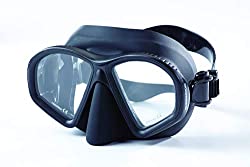
Photo Credit: Amazon
Simplicity and straightforwardness are at the heart of this mask’s design and functionality. The internal volume was low enough that normal breathing was enough to equalize the pressure, making it a very convenient mask for freediving. Of course, this also gives great peripheral vision with a wide, unobstructed field of view. The seal on this mask is exceptionally comfortable and works extremely well. Our diving team did not have any leaks whatsoever, even at greater depths. Although it only comes in one color (black matte), we thought it was stylish enough for most people. The nose pocket was not too rigid, adding to the comfort of these goggles. The strap was great and easily adjustable to the desired position, staying securely in place after adjustments.
5. Omer Apnea Mask
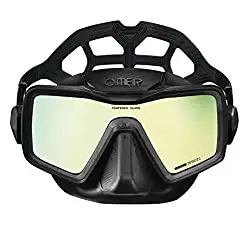
Photo Credit: Amazon
We were surprised to find that this expensive model didn’t perform and other (cheaper) models. The mirrored lenses are great for spearfishing, which works well. The internal volume is very low, and the mask wears comfortably, as it has very soft silicon. The downside is that the silicone skirt did not keep as tight a seal as we would have preferred. Water leaks into this mask in substantial amounts, so we were surprised by its popularity.
Tips On Buying A Low Volume Diving Mask
Before you purchase a mask, you should at least know how to test it and check for its quality. The most important factor is how well the mask fits on your face and creates a seal. Many in the diving community use a great tip to stick the mask to your face and, without fastening the strap, inhale with the mask on. This should make it stick to your face and show you how well the seal will work underwater.
Exhaling in the mask will help show how effective the anti-fog coating can be. Also, check how secure the straps are when adjusted and the quality of materials used in manufacturing the mask.
Summary
You should now have all the information you need to make an informed purchase and find the best diving mask for your requirements. A low volume mask has many benefits and very few drawbacks. Freediving to great depths invariably requires special techniques and equipment, most notably a low-volume mask to help with breath conservation (which is especially important in freediving). Buying a diving mask should not be a difficult task, and hopefully, after reading this article, it won’t be.
